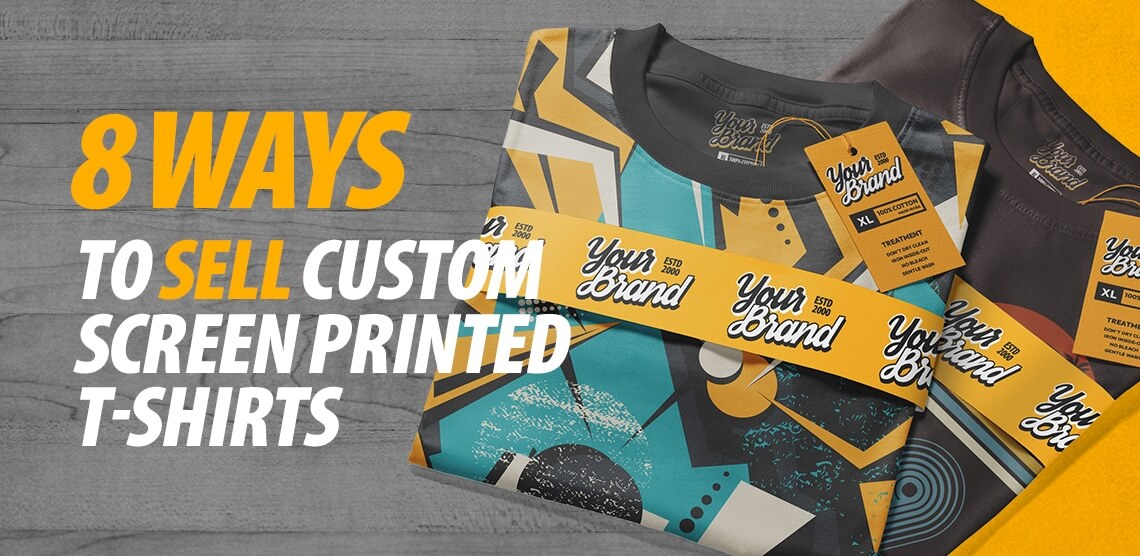Professional Screen Printing Kit for Custom Apparel
Professional Screen Printing Kit for Custom Apparel
Blog Article
Display Printing Uncovered: Whatever You Required to Learn About Tee Shirt and Garment Printing Strategies
Screen printing is a fascinating technique that combines art with technique, offering limitless possibilities for creativity. Prepared to explore the vital aspects that make screen printing an art type?
The Essentials of Screen Printing: Just How It Functions
When you dive right into screen printing, you'll discover it's both a scientific research and an art. At its core, display printing includes producing a stencil, or screen, that allows ink to pass via just in certain locations (screen printing kit). You begin by selecting your design and preparing your display with a light-sensitive solution. As soon as you expose this solution to light, it sets, leaving your layout as an unfavorable area.
Following, you'll blend your inks and prepare your printing surface area. Setting the screen over the material, after that use a squeegee to press ink through the display onto the garment. This procedure needs accuracy, as you want clear, dynamic prints. After printing, you'll cure the ink with heat, guaranteeing it sticks to the material and lasts with laundries. Each step is vital, and mastering them will elevate your screen printing skills, transforming easy garments into special, meaningful pieces.
Sorts Of Display Printing Strategies
Once you grasp the essentials of display printing, it's time to explore the numerous methods that can raise your layouts. One preferred approach is traditional screen printing, where ink is pressed through a stenciled display.
If you're going for great information, take into consideration discharge printing. This strategy removes dye from the textile, leaving a soft, classic look. One more alternative is plastisol printing, known for its toughness and brilliant shades, making it a preferred for numerous brand names. Finally, explore halftone printing to produce gradient impacts and detailed styles. Each strategy has its one-of-a-kind appeal, so don't wait to try them bent on locate what fits your design best!
Vital Equipment for Screen Printing
To accomplish spectacular outcomes in display printing, having the ideal devices is basic. You'll require a sturdy display printing structure, which holds the mesh that moves your layout onto the garment. Next, spend in premium squeegees; these are crucial for using ink evenly throughout the display.
Selecting the Right Inks and Products
When choosing inks and products for display printing, you require to think about the sort of ink that functions finest for your task. Think of textile compatibility to ensure your designs look last and terrific long. Check out environment-friendly ink alternatives to make your printing procedure extra sustainable.
Kinds Of Display Inks
Selecting the ideal screen ink is crucial for attaining vibrant, resilient prints that fulfill your project's demands. There are several sorts of screen inks to examine. Plastisol ink is prominent for its convenience and ease of use, supplying superb color opacity on dark fabrics. Water-based ink, on the various other hand, uses a softer feeling and is eco-friendly, making it ideal for those seeking to lessen their environmental influence. Release inks get rid of dye from the textile, resulting in a soft, classic look but call for details handling. Specialty inks, such as glow-in-the-dark or metallic, can include one-of-a-kind effects to your styles. Examine your project needs and pick the ink that straightens finest with your desired result.

Material Compatibility Factors To Consider
Recognizing textile compatibility is essential for accomplishing top quality display prints, especially because various materials respond uniquely to numerous inks. Constantly examine your inks on example material to guarantee they adhere correctly and maintain color stability. Furthermore, maintain in mind that textile weight and appearance can influence the last result, so selecting the ideal ink and product combination is essential for your task's success.
Eco-Friendly Ink Options
Eco-friendly inks are ending up being a popular choice for screen printers who intend to decrease their environmental influence while maintaining quality. When choosing inks, take into consideration water-based inks, which are less dangerous and less complicated to cleanse up compared to traditional solvents. These inks bond well with materials, supplying vibrant results without hazardous chemicals. You may likewise check out eco-solvent inks that utilize fewer unstable organic compounds (VOCs), making them a more secure option for both your health and wellness and the planet.
In addition, search for inks made from sustainable resources, such as soy or vegetable-based alternatives. By selecting the ideal inks and products, you'll not only develop stunning designs however additionally add to an extra sustainable printing process. Make the switch, and your prints will certainly reflect your commitment to the setting!
Preparing Your Layout for Display Printing

Submit Style Needs
To assure your design looks sharp and vivid on fabric, you'll need to pay close focus to submit layout requirements for display printing. Make certain your design has a transparent background to protect against unwanted white sides on your prints. Maintain shade modes in mind; CMYK is common for display printing, so transform your RGB creates appropriately.
Shade Splitting Up Methods
Color separation is an important action in preparing your layout for display printing, and mastering it can greatly improve your print high quality. You'll require to break your style into individual shades, as each shade calls for a separate screen during printing. Begin by recognizing all the shades in your layout and develop layers for each one. You can utilize software application like Adobe Photoshop or Illustrator to isolate and different colors successfully. Be specific to save each layer as a different file, normally in a format like TIFF or from this source PSD. This precision not just guarantees exact color representation however additionally improves the printing process. By taking note of shade separation, you'll accomplish specialist and lively lead to your screen-printed garments.
Resolution and Size
Achieving the ideal lead to display printing starts with ensuring your style has the best resolution and size. Preferably, your artwork ought to go to least 300 DPI (dots per inch) for sharp, clear prints. If you use lower resolution, your end product could look pixelated and unprofessional.
When it comes to size, take into consideration the dimensions of your print area. Style your art work to match the final print size, preferably producing it in the actual dimensions you'll be publishing. By doing this, you'll prevent any type of unanticipated scaling problems.
Constantly check your design in both vector and raster layouts. Vector graphics can be scaled without losing top quality, making them perfect for screen printing. Preparing correctly will guarantee your design looks impressive on every garment!
Step-by-Step Display Printing Process
Screen printing is a dynamic process that enables you to create dynamic designs on different surface areas. To get started, you'll require a screen, emulsion, and your selected ink. Initially, prepare your screen by cleansing it thoroughly. Next, apply the solution uniformly and allow it dry in a dark location. When completely dry, subject your display to light with your layout positioned on it, which will certainly solidify the solution where the light hits, creating a pattern - screen printing kit.
After rinsing the unexposed solution, your screen prepares. Establish it up on your printing surface area and align your garment under it. Pour ink onto the screen and use a squeegee to push the ink via the pattern onto the textile. Raise the screen carefully and let the print dry. Finally, heal the ink using heat to guarantee longevity. That's it! You have actually successfully screen printed your design.
Tips for Successful Screen Printing Projects
While you're diving right into your screen printing projects, keep in mind that prep work is essential to success. Start by gathering all your products-- inks, mops, you could try these out displays, and garments. A clean office aids prevent unwanted mistakes, so clean up before you start.
Following, validate your art work is high-resolution and properly sized for your garment. Examine your screen for appropriate exposure and tidy it thoroughly to stay clear of spots. When blending your inks, comply with the maker's guidelines to attain the right uniformity.
Throughout printing, apply also pressure with your squeegee for constant outcomes. Do not rush; take your time to confirm each print satisfies your standards. After printing, allow your garments completely dry entirely prior to managing or packaging them.
Last but not least, always keep a sample of your help future reference. By doing this, you can examine your development and boost your strategies in time. Pleased printing!

Often Asked Concerns
The length of time Does It Require To Set up a Screen Printing Job?
Setting up a display printing task usually takes about half an hour to an hour. You'll prepare the displays, mix inks, and change the press. The time varies based upon complexity and experience, so stay organized!
Can I Publish on Different Material Keys In Utilizing the Very Same Strategy?
Yes, you can print on various textile kinds making use of the exact same strategy, yet you'll need to adjust your settings and inks. Some textiles take in ink differently, so exploring guarantees the finest results for every material.
What Prevail Blunders to Avoid in Display Printing?
When screen printing, avoid common errors like using the wrong ink, disregarding proper direct exposure times, or missing pre-press checks. Always test your configuration and maintain tidy displays to ensure quality results each time.
Exactly How Can I Correctly Clean and Keep My Screen Printing Equipment?
To correctly clean and maintain your display printing tools, you should frequently wash displays with proper solvents, examine squeegees for wear, and guarantee all tools are saved dust-free and dry. Uniformity enhances and stops costly fixings performance.
Is Display Printing Eco Friendly Compared to Various Other Methods?
Screen printing can be much more eco-friendly than various other methods, specifically if you utilize eco-conscious materials and water-based inks. By choosing lasting materials and practices, you reduce waste and reduce your effect on the world.
Screen Printing Uncovered: Every Little Thing You Need to Know Concerning Tee Shirt and Garment Printing Methods
At its core, display printing involves producing a pattern, or display, that allows ink to pass through only in details areas. Placement the screen over the material, then use a squeegee to press ink through the screen onto the garment. One popular method is traditional display printing, where ink is pushed with a stenciled display.When picking inks and products for screen printing, you need to take into account the kind of ink that functions why not try here ideal for your job.
Report this page